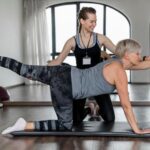Functional fitness workout routines have gained popularity in recent years, with many people embracing this style of training for its practical and holistic approach to physical fitness. Unlike traditional workouts that focus on specific muscle groups or aesthetic goals, functional fitness emphasizes movement patterns and exercises that mimic real-life activities.
In this introductory section, we will explore the concept of functional fitness and its key principles, as well as the benefits it offers to individuals of all ages and fitness levels.
Functional fitness is not just about looking good; it’s about feeling strong, agile, and capable in everyday life. This approach to exercise is designed to improve your overall quality of life by enhancing your ability to perform daily tasks with ease and efficiency.
Whether you’re picking up groceries, playing with your kids, or carrying heavy objects, a functional fitness workout routine can help you build the strength, stability, flexibility, and mobility needed to navigate these activities safely and effectively.
In this article, we will delve into the benefits of functional fitness workouts and explore the key principles that underpin this training methodology. We’ll also provide practical tips for incorporating functional fitness into your daily routine and highlight sample exercises and workouts to get you started on your functional fitness journey.
Whether you’re a beginner looking to improve your basic movement patterns or an athlete striving for peak performance, understanding the fundamentals of functional fitness is essential for achieving long-term health and vitality.
The Benefits of Functional Fitness Workout
Functional fitness workout routines offer a myriad of benefits for overall health and well-being. One of the primary benefits of this type of exercise is its practical application to everyday activities. Functional fitness workouts focus on improving strength, balance, flexibility, and endurance in a way that directly translates to real-life movements and tasks. This can help individuals perform daily activities with greater ease and reduce their risk of injury.
Additionally, functional fitness workouts can lead to improved overall physical performance. By engaging multiple muscle groups and incorporating a variety of movements, these workouts can enhance coordination, agility, and cardiovascular endurance. This not only improves athletic performance but also increases the efficiency of day-to-day movements.
Furthermore, functional fitness workouts are known for their ability to promote joint health and mobility. By emphasizing natural movement patterns and range of motion, these routines can help reduce the risk of joint stiffness and improve flexibility. Over time, individuals may notice increased mobility in their shoulders, hips, and other key joints, leading to improved posture and reduced discomfort during daily activities.
Incorporating a functional fitness workout routine into one’s regular exercise regimen can provide numerous benefits that extend beyond the gym. By focusing on practical movements and overall functionality, individuals can experience improvements in daily performance, physical capabilities, and joint health. Whether it’s lifting groceries or participating in recreational activities, the benefits of functional fitness workouts can have a positive impact on various aspects of everyday life.
Key Principles of a Functional Fitness Workout Routine
Functional fitness workout routines are based on principles that focus on improving overall strength, flexibility, balance, and endurance to help individuals perform everyday tasks more efficiently and reduce the risk of injuries. Here are some key principles to keep in mind when developing a functional fitness workout routine:
1. Multi-joint movements: Functional fitness workouts emphasize exercises that involve multiple joints and muscle groups working together. These movements mimic real-life activities and help improve coordination and stability. Some examples of multi-joint movements include squats, lunges, deadlifts, and push-ups.
2. Core strength: A strong core is essential for functional fitness as it supports good posture, balance, and stability. Incorporating exercises such as planks, Russian twists, and medicine ball throws can help strengthen the core muscles and improve overall body mechanics.
3. Variety and specificity: To ensure a well-rounded functional fitness workout routine, it’s important to include a variety of exercises that target different movement patterns and muscle groups. This includes incorporating activities like resistance training, cardio workouts, yoga, Pilates, and flexibility exercises to address various aspects of physical fitness.
4. Functional movements: The focus of a functional fitness workout routine should be on movements that have real-life applications and contribute to improved daily function. Exercises such as carrying groceries, lifting objects from the ground, pushing/pulling doors or heavy objects can all be simulated in a functional fitness routine to build practical strength for daily activities.
5. Progression and adaptation: As with any workout regimen, progression is key to seeing ongoing results in functional fitness training. Gradually increasing the difficulty of exercises by adding resistance, changing angles or surfaces for stability challenges allows the body to adapt and grow stronger over time.
By incorporating these key principles into a functional fitness workout routine, individuals can enhance their overall physical capabilities while reducing the risk of injury during daily activities.
Sample Functional Fitness Exercises and Workouts
Functional fitness exercises and workouts are designed to improve the body’s ability to perform daily activities and tasks with ease and efficiency. These exercises focus on engaging multiple muscle groups simultaneously, mimicking real-life movements, and improving overall functionality. Here are some sample functional fitness exercises and workouts that you can incorporate into your routine:
Bodyweight Exercises
Bodyweight exercises are a great way to build strength, endurance, and flexibility without the need for equipment. Examples of bodyweight exercises include squats, lunges, push-ups, planks, mountain climbers, and burpees. These exercises engage various muscle groups and can be modified to suit different fitness levels.
Functional Movements
Functional movements such as squatting, bending, reaching, twisting, lifting, and carrying are essential for everyday tasks. Incorporating these movements into your workout routine can help improve mobility, posture, balance, and coordination. Consider adding exercises like kettlebell swings, medicine ball throws, farmer’s walks, or resistance band rotations to target these functional movements.
Circuit Training
Circuit training is a popular method in functional fitness workouts that involves performing a series of exercises in quick succession with minimal rest in between. This form of training helps improve cardiovascular fitness while also targeting strength and endurance. Designing a circuit that includes a mix of compound movements like deadlifts, overhead presses, rows, and box jumps can provide a full-body functional workout.
Incorporating these sample functional fitness exercises into your workout routine can help you develop functional strength and mobility while enhancing your overall physical abilities for daily life activities. Remember to consult with a fitness professional before starting any new exercise program to ensure it aligns with your goals and physical capabilities.
Equipment and Props for Functional Fitness Workouts
When it comes to functional fitness workouts, the use of equipment and props can enhance the effectiveness of your routine. Incorporating specific tools can help target different muscle groups and improve overall strength, stability, and mobility. Here are some essential equipment and props that can be used in a functional fitness workout routine.
Resistance Bands
Resistance bands are versatile and affordable tools that can be used to add resistance to various exercises such as squats, lunges, rows, and presses. They come in different resistance levels, making them suitable for individuals of all fitness levels. Resistance bands are also great for improving flexibility and range of motion.
Kettlebells
Kettlebells are effective for functional fitness workouts because they require coordination, stability, and strength to perform various exercises such as swings, squats, Turkish get-ups, and overhead presses. The off-centered weight of a kettlebell also engages stabilizing muscles that may not be activated with traditional dumbbells.
Medicine Balls
Medicine balls are excellent for improving explosive power and core strength. Exercises like medicine ball slams, throws, twists, and wall balls engage multiple muscle groups while challenging balance and coordination. They are also beneficial for enhancing agility and cardiovascular endurance.
Incorporating these equipment and props into your functional fitness workout routine can add variety and intensity to your training. However, it’s important to use proper form and technique when working with these tools to prevent injury. Additionally, always choose equipment that is appropriate for your current level of fitness and gradually progress as you become stronger.
Safety and Injury Prevention in Functional Fitness Training
When engaging in a functional fitness workout routine, it is important to prioritize safety and injury prevention. Functional fitness exercises often involve dynamic movements that challenge multiple muscle groups and joints simultaneously. As a result, there is an increased risk of injury if proper precautions are not followed. To ensure a safe and effective workout experience, it is crucial to understand the potential risks associated with functional fitness training and take proactive measures to mitigate them.
One key principle of injury prevention in functional fitness training is the emphasis on proper form and technique. Because many functional fitness exercises involve complex movements, such as squats, lunges, and rotational patterns, maintaining correct posture and alignment is essential for reducing the risk of injury.
Additionally, it is important to start with lighter weights or resistance bands when learning new exercises to allow the body to adapt and strengthen gradually. This approach not only reduces the likelihood of strain or overuse injuries but also helps improve overall movement mechanics.
Incorporating adequate rest periods into a functional fitness workout routine is another essential aspect of injury prevention. While it can be tempting to push through fatigue or discomfort, overtraining increases the risk of muscular imbalances, joint stress, and burnout.
By allowing sufficient time for rest and recovery between workouts, individuals can prevent overuse injuries and support their body’s natural healing processes. Furthermore, integrating mobility work, stretching, and foam rolling into the training routine can help maintain flexibility and reduce muscular tension, contributing to injury prevention in functional fitness workouts.
| Principles of Injury Prevention | Importance |
|---|---|
| Emphasis on proper form and technique | Reduces risk of injury by maintaining correct posture and alignment. |
| Incorporating adequate rest periods | Prevents overtraining-related injuries by allowing sufficient time for recovery. |
| Mobility work, stretching, and foam rolling | Maintains flexibility and reduces muscular tension to help prevent injuries. |
Nutrition and Functional Fitness
When it comes to functional fitness workout routines, nutrition plays a crucial role in fueling your body for optimal performance. Proper nutrition not only supports your workouts but also aids in muscle recovery and overall health. A well-balanced diet is essential to ensure that you have the energy and nutrients needed to power through your functional fitness workouts.
One key principle of a functional fitness workout routine is maintaining a diet that is rich in lean proteins, complex carbohydrates, healthy fats, and plenty of fruits and vegetables. Lean proteins such as chicken, fish, tofu, and legumes help support muscle repair and growth. Complex carbohydrates like whole grains, sweet potatoes, and quinoa provide a sustainable source of energy for your workouts. Healthy fats from sources like avocados, nuts, and olive oil aid in nutrient absorption and hormone regulation.
In addition to macronutrients, hydration is another important aspect of fueling your functional fitness workout. Proper hydration ensures that your body can function optimally during exercise and aids in the recovery process post-workout. It’s recommended to drink plenty of water throughout the day, especially before, during, and after your functional fitness workout routine.
| Nutrition | Functional Fitness |
|---|---|
| Lean proteins support muscle repair | Proper nutrition fuels optimal performance |
| Complex carbohydrates provide sustainable energy | A well-balanced diet aids in muscle recovery |
| Healthy fats aid in nutrient absorption | Hydration ensures optimal body function during exercise |
By paying attention to your nutritional intake and making sure you are properly fueled with the right nutrients, you can optimize the benefits of your functional fitness workout routine. Whether you’re engaging in strength training, HIIT circuits, or mobility exercises as part of your functional fitness routine, having a well-rounded nutrition plan will contribute to improved performance and overall well-being.
Tips for Incorporating Functional Fitness Into Your Daily Routine
Incorporating a functional fitness workout routine into your daily schedule can have a dramatic impact on your overall health and well-being. By focusing on exercises that mimic real-life movements, functional fitness can help improve flexibility, strength, balance, and endurance. Here are some tips for seamlessly integrating functional fitness into your daily routine:
- Start with small changes: Incorporating functional fitness doesn’t have to mean overhauling your entire workout routine. Start by adding just a few functional exercises to your existing workouts or replacing one or two traditional exercises with their functional counterparts.
- Make it a part of your everyday activities: Look for opportunities throughout the day to incorporate functional movements. This could include squatting instead of bending over to pick something up off the floor, or doing calf raises while waiting in line.
- Set specific goals: Whether it’s improving your balance, increasing your upper body strength, or enhancing your flexibility, setting specific goals for your functional fitness training can help keep you motivated and focused.
By making these simple adjustments to your daily routine, you can gradually build a more comprehensive functional fitness workout plan that seamlessly fits into your lifestyle. The key is to be consistent and patient as you work towards improving your overall physical function and performance. Remember that every small effort counts towards achieving greater overall health through a well-rounded functional fitness workout routine.
Conclusion
In conclusion, a functional fitness workout routine offers numerous benefits for individuals of all fitness levels and ages. Understanding the principles of functional fitness and incorporating it into your daily routine can lead to improvements in strength, balance, flexibility, and overall physical health. By focusing on movements that mimic everyday activities, functional fitness workouts can help individuals build a strong foundation for performing daily tasks more efficiently and with reduced risk of injury.
Furthermore, the sample exercises and workouts provided in this article demonstrate the versatility of functional fitness training. Whether using bodyweight exercises or incorporating equipment and props, there are endless options for developing a comprehensive functional fitness workout routine that targets different muscle groups and movement patterns.
It is important to remember that safety is paramount in any exercise regimen. Paying attention to proper form, gradually increasing intensity, and listening to your body can help prevent injuries during functional fitness training. Additionally, fueling your body with proper nutrition will provide the energy needed to power through these workouts. By embracing the power of functional fitness, individuals can experience improved physical function both inside and outside of the gym.
Frequently Asked Questions
How Do You Plan a Functional Workout?
Planning a functional workout involves identifying the specific movements and activities you want to improve, such as squatting, bending, lifting, pushing, or pulling. It’s important to choose exercises that mimic those movements and use various equipment like resistance bands, kettlebells, or bodyweight exercises.
What Is a Functional Fitness Exercise?
A functional fitness exercise is any movement that helps you perform everyday activities more efficiently and without causing injury. These exercises focus on multiple muscle groups and joints, helping you improve balance, coordination, strength, and flexibility. Examples include squats, lunges, deadlifts, push-ups, and rows.
How Many Days a Week Should I Do Functional Training?
The frequency of functional training depends on your fitness level and goals. For beginners or those new to this type of training, starting with 2-3 days a week is beneficial to allow for proper recovery.
Advanced individuals might incorporate functional training 4-5 days a week but still prioritize rest days for recovery and muscle growth. It’s essential to listen to your body and adjust as needed based on how you feel after each session.

Passionate about providing useful information to anyone with an interest in the field of Personal Training, I strive to pass on to our readers quality information and to answer any questions about Personal Trainers, the work they do and how to become one.





